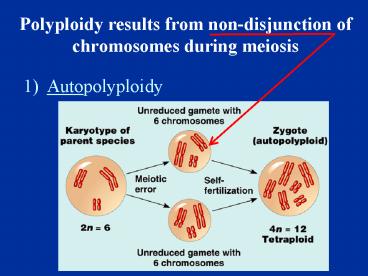Polyploidy results from nondisjunction of chromosomes during meiosis - PowerPoint PPT Presentation
1 / 35
Title:
Polyploidy results from nondisjunction of chromosomes during meiosis
Description:
Polyploidy results from non-disjunction of chromosomes during meiosis. 1) Autopolyploidy ... Hybridization followed by non-disjunction ... – PowerPoint PPT presentation
Number of Views:464
Avg rating:3.0/5.0
Title: Polyploidy results from nondisjunction of chromosomes during meiosis
1
Polyploidy results from non-disjunction of
chromosomes during meiosis
- 1) Autopolyploidy
2
- 2) Allopolyploidy
- Hybridization followed by non-disjunction
3
Polyploids are phenotypically different
reproductively isolated from parents
- Instant speciation
4
- Wheat evolved by allopolyploidy
5
Polyploidy is rare in animals
An all-female species
New Mexican whiptail
6
How many species are there?
- 1.5 - 2 million named species
- 42,000 vertebrates
- 13 - 14 million total (?)
- (mostly insects microorganisms in tropics)
- gt 99 of all species have gone extinct
7
How is evolutionary history reconstructed?
8
How is evolutionary history reconstructed?
- 1. Comparison of living species
Homologies indicate common ancestry
9
Time ?
10
Molecular comparisons
Frog
Monkey
Chimp
Whale
A Molecular Clock
Time ?
11
How is evolutionary history reconstructed?
- 2. Fossil Record
12
Four Geological Eras
Cenozoic
Mesozoic
Paleozoic
13
Four Geological Eras
- 1. Precambrian (4.6 0.6 b.y.a.)
- initially no atmospheric O2
- organic molecules accumulated
- (primordial soup)
14
Origin of Life
3.5 b.y.a. - First Fossils
3.9 b.y.a. - Origin of Life?
15
Evolutionary Innovations of The Precambrian
- Photosynthesis, and then aerobic respiration
- Eukaryotic cell
- - endosymbiosis
- Multicellularity ?
- 1 b.y.a
16
(No Transcript)
17
- 2. Paleozoic (543 245 m.y.a.)
Paleozoic
18
- 2. Paleozoic (543 245 m.y.a.)
- Begins with "Cambrian Explosion"
- - all remaining invertebrate phyla evolve in
40-50 million years
19
Evolutionary Innovations of The Paleozoic
- gut with two openings
20
Evolutionary Innovations of The Paleozoic
- gut with two openings
- complex nervous system (cephalization)
21
Evolutionary Innovations of The Paleozoic
- gut with two openings
- complex nervous system (cephalization)
- shells exoskeletons
22
Three Vertebrate Classes evolved during the
Paleozoic
- Fish 500 mya
23
Three Vertebrate Classes evolved during the
Paleozoic
- Reptiles 250 mya
- Amphibians 400 mya
- Fish 500 mya
Modification of pre-existing structures
24
Paleozoic ended with a major Extinction
- gt 90 of all species disappear
Pangea forms
Sea level drops
Volcanic activity
25
- 3. Mesozoic (245 - 65 m.y.a.)
Mesozoic
26
- 3. Mesozoic (245 - 65 m.y.a.)
- "Age of Reptiles"
Birds Mammals appear early but dinosaurs are
ecologically dominant
27
Evolutionary innovations of the Mesozoic
- flowering plants
Cycad
Magnolia
28
- homeothermy
29
- vertebrate flight
30
Mesozoic ends with major Extinction
- 50 of all species disappear
Asteroid Impact
Volcanic Activity
31
- 4. Cenozoic (65 m.y.a. - today)
Cenozoic
32
- 4. Cenozoic (65 m.y.a. - today)
- "Age of Mammals"
diversified to fill empty niches
33
History of life is marked by
- Innovation leading to adaptive radiation
- Extinction leading to adaptive radiation
34
Species adapt to fill ecological niches
35






























